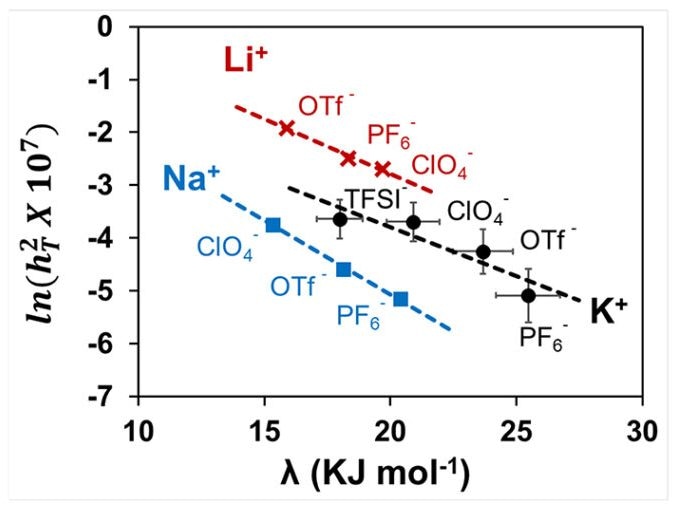Jul 11 2019
Metal-air batteries are known to possess excellent gravimetric energy densities, and hence they have been pursued as an ideal replacement to lithium-ion batteries.
 This graph shows the correlations between three parameters that lead to a single descriptor which provides a rational basis to design electrolyte compositions for high-power alkali metal-oxygen batteries, including potassium-air batteries. This research from the McKelvey School of Engineering will help engineers find the right electrolyte for new and improved batteries, including potassium-air batteries. (Image credit: Ramani Lab)
This graph shows the correlations between three parameters that lead to a single descriptor which provides a rational basis to design electrolyte compositions for high-power alkali metal-oxygen batteries, including potassium-air batteries. This research from the McKelvey School of Engineering will help engineers find the right electrolyte for new and improved batteries, including potassium-air batteries. (Image credit: Ramani Lab)
Such batteries can possibly allow electric cars to travel approximately a thousand miles or more on just a single charge.
Potassium-air battery is a potential new member of the alkali-metal-air battery family and contains over three times the hypothetical gravimetric energy density of lithium-ion batteries. As such, a right electrolyte has to be selected for designing potassium-air batteries, but this task is rather complicated. An electrolyte is a liquid that facilitates ion transport between the anode and cathode.
Electrolytes are generally selected using a trial-and-error method based on rules of thumb that correlate a number of electrolyte characteristics. This is followed by comprehensive (and time intensive) testing of many electrolyte candidates to check whether the required performance has been achieved.
At Washington University in St. Louis, a research team, headed by Vijay Ramani—the Roma B. and Raymond H. Wittcoff Distinguished Professor of Environment & Energy at the McKelvey School of Engineering—has now demonstrated how a single, easy-to-measure parameter can be used for selecting the right electrolytes for alkali-metal air batteries.
The study was recently reported in the Proceedings of the National Academy of Sciences on July 10th, 2019.
Ramani’s group examined the underlying interactions between the solvent and salt in the electrolyte and demonstrated how these interactions can have an impact on the overall performance of the battery. The researchers created a new parameter, called the “Electrochemical” Thiele Modulus, which is a measure of the ease of the transfer of ions and their reaction at the surface of an electrode.
The new study records the first time that the Marcus-Hush theory of electron transfer—which won the Nobel Prize—was used for studying the effect of electrolyte composition on the movement of ions via the electrolyte, and their reaction at the electrode’s surface.
It was shown that the Thiele Modulus considerably decreases with increasing solvent reorganization energy—a measure of the energy required to change the solvation sphere of a dissolved species. Consequently, the solvent reorganization energy could be used to sensibly choose electrolytes for high-performance metal-air batteries. This means, trial-and-error approaches are no longer needed.
We started out trying to better understand the influence of the electrolyte on the oxygen reduction reaction in metal-air battery systems. We ended up showing how the diffusion of ions in the electrolyte and the reaction of these ions on the electrode surface are both correlated to the energy needed to break the solvation shell around the dissolved ions.
Shrihari Sankarasubramanian, Study Lead Author and Research Scientist, Washington University in St. Louis
Sankarasubramanian is also a part of Ramani’s team.
“Showing how a single parameter descriptor of the solvation energy correlates with both ion transport and surface reaction kinetics is a breakthrough advance,” stated Ramani. “It will allow us to rationally develop new high-performance electrolytes for metal-air batteries.”
Joshua Kahky, a rising junior in the Department of Energy, Environmental and Chemical Engineering, is the study’s second author. He helped in conducting the study as an undergraduate summer intern in Ramani’s laboratory.